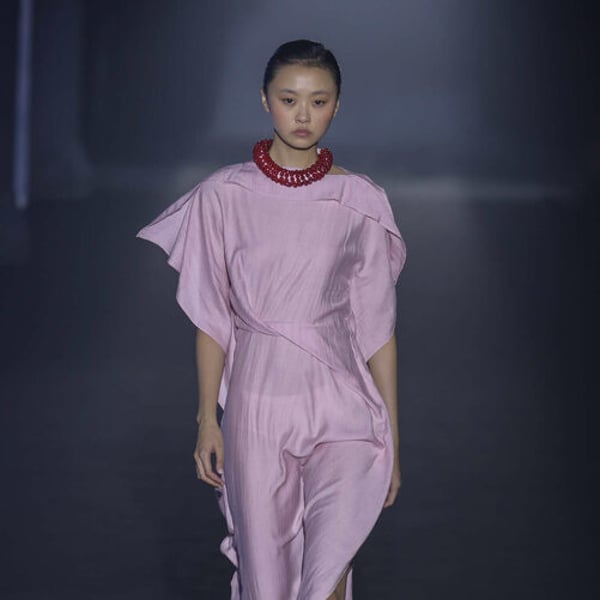Fashion
Germany’s Hugo Boss lifts profitability despite 1% dip in Q3 sales

The gross margin of the company rose 100 basis points (bps) to 61.2 per cent, reflecting lower freight costs and sourcing efficiencies, while operating expenses fell 3 per cent due to stringent cost management.
Hugo Boss has reported a 1 per cent YoY sales decline in Q3 2025 but achieved stronger profitability through cost control and sourcing efficiency.
Gross margin rose 100 bps to 61.2 per cent, while EBIT held steady at €95 million (~$109.25 million) with a 9.6 per cent margin.
EPS increased 7 per cent, and free cash flow 63 per cent.
The company reaffirmed its FY25 guidance amid currency headwinds.
Operating profit (EBIT) remained broadly stable at €95 million (~$109.25 million), translating to a 9.6 per cent EBIT margin, up 30 basis points YoY. Earnings per share (EPS) increased 7 per cent to €0.85, supported by stronger financial results and lower net expenses. Free cash flow rose 63 per cent, driven by improved CapEx efficiency, Hugo Boss said in a press release.
Regionally, Americas showed renewed momentum (+3 per cent), while EMEA declined slightly (–2 per cent), with gains in Germany and France offset by weaker UK sales. The Asia/Pacific region fell 4 per cent, mainly due to lower sales in China, though Southeast Asia and Japan showed modest improvement.
“Despite ongoing global market volatility in Q3, we remained focused on our strategic priorities, emphasising long-term brand strength over short-term gains,” said Daniel Grieder, CEO at Hugo Boss. “We achieved meaningful efficiency gains, delivering notable gross margin expansion and streamlined expenses. This is clear evidence of the operational excellence and resilience at the core of our business model. Accordingly, we confirm our 2025 top-and bottom-line guidance while remaining vigilant in navigating ongoing market uncertainties.”
“Our ‘CLAIM 5’ strategy has been pivotal in driving our growth and establishing a strong foundation for long-term success. With our two iconic brands, a robust business platform, and the passion and commitment of our global teams, we are well positioned to create lasting value for our shareholders,” added Grieder.
The Boss Menswear line remained stable YoY, supported by the Beckham X Boss collection launch and the Boss Spring/Summer 2026 Fashion Show in Milan, both of which significantly boosted brand engagement on social media.
By contrast, Boss Womenswear and Hugo reported sales declines of 9 per cent and 5 per cent, respectively, as the company continued to refine product assortments and streamline distribution.
Channel-wise, digital sales advanced 2 per cent, driven by growth on its official website and through digital partner channels. Brick-and-mortar retail remained flat but improved sequentially from Q2, while wholesale declined 5 per cent due to delivery timing, expected to reverse in Q4.
Marketing investments fell 8 per cent to €70 million as the company prioritised high-impact initiatives like the Milan Fashion Show. Administration expenses were 2 per cent lower, highlighting strict overhead control. The company’s trade net working capital rose 11 per cent to €909 million, reflecting higher inventories and reduced payables but remained below Q2 levels.
Hugo Boss reaffirmed its 2025 guidance, expecting group sales and EBIT at the lower end of the ranges due to persistent macroeconomic and currency headwinds. Full-year sales are projected between €4.2 billion and €4.4 billion, while EBIT is forecast between €380 million and €440 million.
The company expects to maintain its EBIT margin within 9-10 per cent, improve efficiency through sourcing and administrative optimisation, and limit capital expenditure to the lower end of €200–250 million.
Fibre2Fashion News Desk (SG)
Fashion
080 Barcelona Fashion to take place at Port Vell in April

Published
December 22, 2025
080 Barcelona Fashion has a new venue. The Catalan catwalk, which bid farewell last October to the Sant Pau Art Nouveau Site, will hold its next edition from April 14 to 17 at the Port of Barcelona, across the Port Vell and Marina Vela spaces.
The fashion platform, promoted by the Department of Business and Labour through the Catalan Government’s Trade, Crafts and Fashion Consortium, announced the move on Monday. With this change of setting, 080 Barcelona Fashion “kicks off a new chapter” that strengthens “the link between fashion and the city, with the sea as a global connector,” it said in a statement.
After years cementing its role as a showcase for emerging talent and with a clear and growing international outlook, 080 Barcelona Fashion aims to open up further to the city and position itself as “a megaphone for creativity.”
“This boost consolidates Catalonia and Barcelona as leaders in the fashion world, reinforcing their role as a creative and innovative hub, and with a clear international outlook,” the platform emphasised in a statement.
Its current director, Marta Coca, outlined the essence of the new location in October: “We want a completely different style to the recent editions, where modernism has taken centre stage. We are looking for a location that, while different, also defines Barcelona.”
The 37th edition of the event will look out to the sea from one of the city’s icons and attractions. The cycle beginning in April is aligned with the “Fashion Plan 2025-2030” promoted by Barcelona City Council, which made its debut as an investor in the event last October with a contribution of €150,000 (from a total budget of €2.15 million). The plan aims to “integrate fashion into the cultural, creative and economic map of the city and position Barcelona as a fashion capital.”
At its most recent edition at the Sant Pau Art Nouveau Site, 080 Barcelona Fashion welcomed more than 11,000 attendees and featured 24 brands, including labels such as Moisés Nieto, Acromatyx, Guillermina Baeza, Custo Barcelona and Carlota Barrera. It was an edition marked by new formats and synergies with public and private platforms in the sector.
This article is an automatic translation.
Click here to read the original article.
Copyright © 2025 FashionNetwork.com All rights reserved.
Fashion
Right wing urges boycott of iconic Brazilian flip-flops
By
AFP
Published
December 22, 2025
Prominent figures on Brazil’s right wing are calling for a boycott of Havaianas, the iconic Brazilian flip-flop sandals, over an ad seen as taking sides ahead of next year’s presidential elections.
In a video posted on the brand’s social media accounts, actress Fernanda Torres urges the public “not to start 2026 on the right foot,” but “on both feet.”
Torres, a supporter of the Brazilian left, was the lead actress in the Brazilian film “Ainda Estou Aqui” (“I’m Still Here”), which won the Oscar for Best Foreign Language Film this year.
The advertisement has sparked outrage in conservative circles.
Eduardo Bolsonaro, one of the sons of far-right former president Jair Bolsonaro — who is serving a 27-year prison sentence for an attempted coup after losing the last election — took to Instagram on Sunday to register his disgust.
In a video, he throws a pair of the flip-flops, recognizable from their straps adorned with the Brazilian flag, into the trash.
“Havaianas used to be a national symbol. I’ve seen many foreigners wearing this Brazilian flag on their feet… but I’m sorry, I’m going to throw these flip-flops in the trash,” says the US-based, former Brazilian lawmaker.
Conservative congressman Rodrigo Valadares posted on X: “Havaianas has chosen its side. The RIGHT has opted for a boycott.”
“My feet are burning on the asphalt, but Havaianas, never again,” right-wing influencer Thiago Asmar posted Monday on Instagram, where he has more than two million followers.
Havaianas are among the world’s best-selling sandals. The Alpargatas group, which owns the brand, employs 10,000 people and sold 226.6 million pairs of flip-flops in 2024, mostly in Brazil, according to its LinkedIn page.
The company has not responded to AFP requests for comment.
Left-wing congresswoman Duda Salabert denounced the reactions from the right as “idiotic attacks,” saying calls for a boycott threatens jobs in Minas Gerais, the southeastern state she represents, where one of the brand’s factories is located.
Torres won the Golden Globe for Best Actress for “I’m Still Here,” which recounts the years of the military dictatorship in Brazil, a period often evoked with nostalgia by Bolsonaro’s supporters.
South America’s largest nation is set to hold general elections in October 2026. Leftist President Luiz Inacio Lula da Silva, who defeated Bolsonaro in 2022, has said he plans to run for a fourth term.
Copyright © 2025 AFP. All rights reserved. All information displayed in this section (dispatches, photographs, logos) are protected by intellectual property rights owned by Agence France-Presse. As a consequence you may not copy, reproduce, modify, transmit, publish, display or in any way commercially exploit any of the contents of this section without the prior written consent of Agence France-Presses.
Fashion
eBay, Vestiaire Collective, H&M’s Sellpy among Europe’s top 10 sustainable re-commerce marketplaces

Published
December 22, 2025
French refurbished tech e-tailer Back Market is Europe’s top-ranked sustainable resale platform, according to Cross-border Commerce Europe (CCE). Three fashion resale specialists, eBay, Vestiaire Collective and H&M’s Sellpy, were among the ranking’s top-10 platforms, with Vinted in 11th place.
The CCE ranking is based on an analysis of the various players’ CSR pledges, cross-referencing the share of their business that falls strictly in the sustainability category with a weighted audit of over 75 sector certifications (like B-Corp and Fashion Pact). Besides certifications, the CCE methodology also assessed the business models, putting a premium on circularity initiatives (like resale and repair) and the presence of alternative services such as product rental, customisation, on-demand production, etc.
Europe’s top-ranked sustainable marketplace was French refurbished tech e-tailer Back Market, ahead of Etsy (USA), OLX (the Netherlands) and Refurbed (Austria). eBay came fifth, ahead of British used photo and video equipment e-tailer MPB.
Vestiaire Collective, the French specialist in second-hand premium and luxury fashion, ranked seventh, followed by Sellpy (owned by Swedish group H&M), by British used tech specialist CeX, and by another French high-end pre-owned fashion marketplace, Collector Square. Vinted was ranked 11th.
Among the factors negatively affecting CCE’s sustainability rating are the carbon impact associated with air freight, high return rates, and a business model based on fast fashion. China-based businesses raised major ethical concerns in terms of human rights compliance, while lack of transparency on traceability was another factor negatively affecting a marketplace’s ranking.
“The re-commerce market is projected to account for 7.4% to 7.8% of the fashion and beauty industry by 2026, up from 6.9% in 2025,” stated CCE, adding that cross-border e-commerce generates 70% of the re-commerce sector’s sales volume.
In 2025, CCE said that marketplaces accounted for 74% of Europe’s online re-commerce GMV (which was up by 18%), generating a revenue of €90 billion out of a total of €121 billion.
Copyright © 2025 FashionNetwork.com All rights reserved.
-

 Business1 week ago
Business1 week agoStudying Abroad Is Costly, But Not Impossible: Experts On Smarter Financial Planning
-

 Business1 week ago
Business1 week agoKSE-100 index gains 876 points amid cut in policy rate | The Express Tribune
-

 Fashion5 days ago
Fashion5 days agoIndonesia’s thrift surge fuels waste and textile industry woes
-

 Sports1 week ago
Sports1 week agoJets defensive lineman rips NFL officials after ejection vs Jaguars
-

 Business5 days ago
Business5 days agoBP names new boss as current CEO leaves after less than two years
-

 Tech1 week ago
Tech1 week agoFor the First Time, AI Analyzes Language as Well as a Human Expert
-

 Entertainment1 week ago
Entertainment1 week agoPrince Harry, Meghan Markle’s 2025 Christmas card: A shift in strategy
-

 Tech5 days ago
Tech5 days agoT-Mobile Business Internet and Phone Deals


















